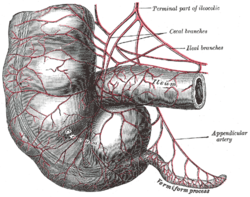
Mitrofanoff appendicovesicostomy
Encyclopedia

Vermiform appendix
The appendix is a blind-ended tube connected to the cecum , from which it develops embryologically. The cecum is a pouchlike structure of the colon...
is used to create a conduit between the skin surface and the urinary bladder
Urinary bladder
The urinary bladder is the organ that collects urine excreted by the kidneys before disposal by urination. A hollow muscular, and distensible organ, the bladder sits on the pelvic floor...
.
Description of procedure
In the procedure, the surgeonSurgeon
In medicine, a surgeon is a specialist in surgery. Surgery is a broad category of invasive medical treatment that involves the cutting of a body, whether human or animal, for a specific reason such as the removal of diseased tissue or to repair a tear or breakage...
separates the appendix from its attachment to the cecum, while maintaining its blood supply. Then he/she creates an opening at its blind end and washes it. One end is connected by surgical sutures to the urinary bladder and the other is connected to the skin to form a stoma
Stoma (medicine)
A stoma is an opening , either natural or surgically created, which connects a portion of the body cavity to the outside environment...
. Generally, an incision is made into the umbilicus so that it may serve as the canal for the catheter.
Urine is typically drained several times a day by use of a catheter inserted into the Mitrofanoff canal.
Indications
The procedure is typically performed when there is a blockage of the normal outlet (as in urethral cancerUrethral cancer
Urethral cancer is cancer originating from the urethra. Cancer in this location is rare, and the most common type is papillary transitional cell carcinoma.- Symptoms :Symptoms that may be caused by urethral cancer include:...
) or when there is a need for frequent, often uncomfortable, catheterizations
Foley catheter
A Foley catheter is a flexible tube that is often passed through the urethra and into the bladder. The tube has two separated channels, or lumens, running down its length. One lumen is open at both ends, and allows urine to drain out into a collection bag...
(as in neurogenic bladder
Neurogenic bladder
Neurogenic bladder refers to dysfunction of the urinary bladder due to disease of the central nervous system or peripheral nerves involved in the control of micturition .-Causes:...
).
The most common patients who undergo this procedure are those who are dependent on catheterization to eliminate urine, such as paraplegic individuals (typically those born with spina bifida
Spina bifida
Spina bifida is a developmental congenital disorder caused by the incomplete closing of the embryonic neural tube. Some vertebrae overlying the spinal cord are not fully formed and remain unfused and open. If the opening is large enough, this allows a portion of the spinal cord to protrude through...
). The Mitrofanoff procedure allows the individual to self-catheterise so that he or she is not dependent on a family member or a medical professional to catheterize him or her.
The Mitrofanoff procedure has been found to improve the life of people with spinal cord injuries, by increasing their independence.
Relation to MACE
The Malone antegrade continence enemaMalone antegrade continence enema
A Malone antegrade continence enema, also known as Malone procedure and by the abbreviation MACE, is a surgical procedure used to create a continent pathway proximal to the anus that facilitates fecal evacuation using enemas....
(MACE), used to treat fecal incontinence
Fecal incontinence
Fecal incontinence is the loss of regular control of the bowels. Involuntary excretion and leaking are common occurrences for those affected. Subjects relating to defecation are often socially unacceptable, thus those affected may be beset by feelings of shame and humiliation...
, is like the Mitrofanoff procedure as it uses the Mitrofanoff principle
Mitrofanoff principle
In urology, the Mitrofanoff principle is the creation of a passage way for urine or enema fluid that, by its construction, has a valve mechanism to allow continence.Procedures which make use of the Mitrofanoff principle:*Mitrofanoff procedure...
and, thus, can be considered an analogous procedure.
As fecal and urinary incontinence frequently co-exist, a MACE is often created at the same time as a continent catheterizable urinary conduit.
Relation to Monti procedure
If the vermiform appendixVermiform appendix
The appendix is a blind-ended tube connected to the cecum , from which it develops embryologically. The cecum is a pouchlike structure of the colon...
is not available, due to appendectomy, or unusable for another reason, the Monti procedure
Monti procedure
The Monti procedure is a surgical procedure in which a part of the gastrointestinal tract is used to create a continent conduit between the skin surface and the urinary bladder or a neobladder.-Eponym:...
is done.

